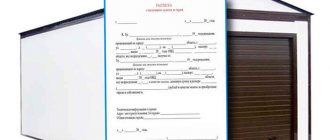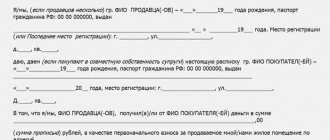Fill out online and print
In modern conditions, a car has truly become not a luxury, but a means of transportation, which some citizens cannot do without. But in order not to worry about your car (and there are plenty of reasons to worry: theft, vandals, “jokers”, etc.), the best option is to keep it in a garage, which is often more difficult to purchase than the car itself. And it is better not to do this procedure without such important paper as a receipt for receipt of funds.
Receipt structure
So, first, why do you need to issue a receipt for receipt of funds for the garage? This document is insurance for the buyer of the property. That is, having received this paper in his hands, he receives a serious “trump card” in case of litigation with the seller. Therefore, a receipt for receipt of funds is most often drawn up when the parties are unfamiliar and there is no reason for them to trust each other.
This document does not have a unified form, but in the course of legal practice, standard content has developed.
Document structure:
- Full name: “Receipt for receipt of funds for the garage.”
- Date of receipt.
- Detailed information about the originator of the receipt (seller) and the “addressee” (buyer). It is necessary to indicate: last name, first name, patronymic;
- age;
- registration;
- citizenship;
- number and series of the civil passport;
- square;
Popular questions about the article
✅ Why do you need to issue a receipt for receipt of funds for the garage?
There are several reasons:
- This is insurance for the buyer;
- evidence of service litigation with the seller;
- necessary when the parties are unfamiliar and there is no reason for them to trust each other.
✅ Is there a unified form of receipt?
The law does not establish the form of the receipt, but in the course of legal practice the standard content has developed:
- name of the document, date of preparation;
- details of both parties;
- information about the subject of the transaction indicating its value;
- date of document preparation and signature.
✅ Is the printed version of the receipt legally binding?
The printed version with signature must be certified by a notary. Only in this case does it have legal force.
✅ How many copies of the receipt are made?
A receipt for receipt of funds for the garage must be drawn up in a single copy, which will remain with the buyer. This is done so that no one other than this party to the transaction can use it in the event of litigation.
✅ Is it necessary to have a document certified by a notary?
In order for the receipt of money to have legal force, you must select one of the following actions:
- Have it certified by a notary.
- Involve two independent witnesses who will leave their signatures on the document.
Receipt for receipt of funds
The transfer of cash from one person to another must be accompanied by the preparation of a special receipt. Most often, this document is used in relations between individuals, but sometimes it can also be used between ordinary citizens and organizations (for example, when it comes to banks or microfinance companies).
For your attention! This document can be downloaded from ConsultantPlus .
Why do you need a receipt?
A receipt is a document that confirms that money was transferred from one individual or legal entity to another person as a loan or for other reasons.
The receipt contains information about how much money was given, under what conditions, and in what period it should be returned to the lender.
In cases where disagreements arise between the creditor and the debtor and one of them decides to go to court, it is the receipt that becomes the official document that proves the fact of the transfer of money, and also shows the conditions for their use and the time frame within which they should have been received given back.
A receipt is not one of the mandatory documents that must accompany the transfer of cash (by the way, in relations between citizens there are no such documents at all), but it is recommended.
When is the document most often used?
There are many reasons for creating a receipt for receiving funds:
- purchase and sale of goods;
- payment for services or rent;
- simple debt, etc.
It should be noted that in a situation where we are talking about a debt obligation, the parties sometimes enter into a loan agreement between themselves - it is more serious from the point of view of the law, because contains more complete and detailed information, but must be drawn up according to a certain scheme and structure, while a receipt is simpler in terms of design and at the same time has almost equal legal force (provided, of course, that it contains some mandatory information).
Who writes the receipt
IMPORTANT! The receipt is always written on behalf of the person who accepts the cash.
However, in some cases, citizens who are unable to take money in person resort to the help of representatives. In this case, the receipt must indicate the fact that the money was accepted by proxy, indicating the date, place of issue, number and other individual parameters.
Do I need to get it certified by a notary?
The obligation to certify a receipt by a notary is not stipulated in the legislation of the Russian Federation, i.e. Each lender has the right to decide for himself whether he is interested in having the receipt certified by the signature of an employee of a notary office or not.
However, the very fact of having a notary’s autograph gives the receipt greater significance, so you should not neglect it.
The only minus here, or rather, even two – time costs and additional financial expenses.
Why are witnesses needed?
Some lenders prudently enlist the support of witnesses when transferring money. They may be uninterested persons, information about whom is also required to be included in the receipt (their full name, passport details and address of residence).
With their signatures, they confirm the fact that the money was transferred exactly in the amount stated in the receipt and on the conditions indicated in it.
In fact, in some way the witnesses perform the function of a notary.
Rules for drawing up receipts
This document is formed in simple written form in any form on a regular sheet of paper. It is also possible to print the receipt on a computer, but this option is not considered the best, since if there is a need for a graphological or handwriting examination, such a receipt will not be the most convenient object of study.
The text must indicate:
- date and place of document formation;
- last name, first name and patronymic of the person who takes the money, his passport details, address of residence (official and actual). Similarly, the receipt contains information about who gives the money;
- amount - it must be indicated in numbers and words;
- if cash is transferred in foreign currency, we advise you to indicate its current exchange rate and the amount in which the debt will need to be repaid;
- deadline for refund;
- return method: cash or by bank transfer - to a card or bank account) and return method - lump sum or in installments. If the second option is chosen, you need to draw up a detailed payment schedule;
- in the case where money was given, what is called “at interest,” this must also be indicated in the document (and the amount of the interest rate must be specified).
Finally, the receipt must be certified by the signature of the person who accepts the money (it is desirable that the signature matches the one in his passport) and the autographs of witnesses, if any, during the money transfer procedure. If desired, the lender can also sign the document.
The receipt is drawn up in a single copy and handed over to the lender.
After drawing up the receipt
When it comes to getting your money back, this also needs to be documented. There are two ways to confirm debt repayment:
- put a mark that the funds were given back directly under the receipt;
- simply return the document to the debtor, who will probably destroy it immediately.
Source: https://assistentus.ru/forma/raspiska-v-poluchenii-deneg/
Nuances to remember when drawing up a receipt
Also, when drawing up a receipt for receiving money for a garage, you need to remember certain nuances.
Firstly, in this matter you cannot limit yourself to an oral agreement. The receipt is, in fact, the only evidence that the seller received the money. And if a conflict occurs between the parties to the transaction and the matter goes to court, only she can confirm the fact that the buyer has fulfilled all his obligations in full.
Secondly, you need to draw up a receipt when you plan to transfer the entire agreed amount of money. Then this document is transferred to the buyer.
Thirdly, the document must be drawn up personally by the seller. Preferably by hand, in blue ink. The printed version, even with a signature, must be certified by a notary. Only in this case does it have legal force.
Fourthly, before transferring money, the buyer must carefully read the text of the receipt for receipt of funds. If all the information entered is true and the document is signed with the real signature of the seller (can be compared with the signature in a civil passport) - only then can the transfer of money be carried out.
The essence of the receipt from a legal point of view
The importance of the receipt is determined by the legal force of the document, as well as the fact that it can serve as a guarantor of the transaction or the fulfillment of obligations assumed.
Despite the absence of any template for writing receipts established by the current legislation, there are a number of features that came from legal practice. Below you can find some of them.
When making a transaction, it is necessary to take into account the size of the amount that appears in the final documents. The higher the amount, the greater the need to write a receipt. Although in our time, when trust in people has practically disappeared, for any transaction involving the transfer of money or the conclusion of agreements for the provision of services, it is recommended to write a receipt.
This usually does not take much time, but it significantly influences whether the matter will be completed and whether all obligations under the agreements reached will be fulfilled. As mentioned above, when registering transactions with a notary, a purchase and sale agreement is drawn up.
Sometimes situations arise when the contract is ultimately terminated, or maybe even declared invalid, then in this case it is the receipt that can help in eliminating all issues regarding deposits, payments made, unfinished payments, and the like.
When concluding rental agreements, which may be the case in the case of renting a garage, you should also write a receipt that will confirm the fact of payment of the rental price to the lessor.
If we are talking about a purchase, a receipt is drawn up to confirm each financial transaction, be it a deposit, payment of part of the funds, installment plan, advance payment or full payment.
Contents and content part of the receipt
The receipt is drawn up on behalf of the seller or lessor. It indicates that a specific amount of money was received and the buyer fulfilled all obligations, so there are no claims against him. As a result, there are two copies of the receipt, one of which is given to the counterparty, and the second remains with the seller.
Below we propose to consider some of the main points that need to be written down in the text of the receipt. Among other things these are:
- name of the document and its intended purpose. It is necessary to describe what this receipt confirms;
- the city in which the document is drawn up;
- current date of receipt;
- Full name of the person on whose behalf the receipt is drawn up. In this paragraph it is necessary to enter the contact details of the seller or lessor, including his passport details and registration;
- Full name of the person who undertakes to fulfill the obligations specified in the receipt. Here it is also necessary to provide complete information about the contact details of the buyer or tenant, indicating his passport details and registration;
- subject of the receipt. This paragraph implies a detailed description of the operation: sale, purchase, lease, pledge, advance payment, provision of services, etc. It is also necessary to indicate the location of the subject, if possible, and a detailed description of it as such. Is it registered in the correct manner, from the point of view of legislation, and if not, how to confirm ownership of it to the new owner;
- A sum of money that is transferred to the subject of a receipt or non-financial obligation. Typically, the monetary amount is indicated in numbers, and then duplicated in words in parentheses. This is done so that it is impossible to interpret the amount in two ways or to correct it after the parties have signed the document;
- if funds or obligations are paid or fulfilled over a certain period of time, then the deadline for the implementation of all agreements should be indicated;
- if there are witnesses, you must enter their contact details, including passport details and place of residence. This usually concerns the fulfillment of very serious obligations or transactions involving large sums of money;
- date of signature of the receipt;
- signatures of the parties. The autograph is signed if all persons whose details are indicated in the receipt are present. Signatures of witnesses confirm that an agreement has been reached and no one is under pressure from the counterparty.
Nuances and general tips
To the general rule when drawing up a receipt, it is necessary to add accuracy and error-free entry of data and other information. The text of the receipt cannot contain any corrections or spelling errors, otherwise it loses its legal force due to the possible double interpretation of all content.
The receipt is an independent document and does not require additions. Does it need to be certified by a notary? The drafters of the receipt have no such obligation. Although in principle this is possible. The decision on this matter is made personally by its compilers.
There is an opinion that during court proceedings, a receipt certified by a notary has more weight, but the court accepts receipts as a document even without a notary’s seal.
There is one unspoken rule for writing a receipt. It consists of writing a document by hand, rather than using a ready-made form typed on an electronic device.
Witnesses or certification?
In order for the receipt of funds for the garage to receive legal force, there are two options.
The first is certification by a notary. With this option, the seller and buyer may not involve third parties in the procedure, but they will have to spend money on the services of a lawyer (usually one of the parties bears the costs, most often the buyer, due to greater interest).
The second is the signatures of at least two witnesses. With this option, it is not necessary to contact a notary office. But the receipt must also contain the passport details of each witness and their signatures (which are also better compared with those of third parties present in general civil passports).
If the buyer has serious doubts about the seller's trustworthiness, he can exercise both of the above options, but this is only required in exceptional cases. Usually it is enough to either certify the receipt or involve independent witnesses in the procedure.
An important condition is that the witnesses cannot be relatives of the seller or buyer. Otherwise, their signatures and testimony in court will not be accepted.
Certification of a receipt by a notary
It is not necessary to certify a receipt for receipt of money. However, the parties can additionally protect themselves from deception by having the document certified by a notary office, which is important when selling a garage.
You can also give the receipt legal force by putting the signatures of witnesses on the form. You should find two witnesses who can attest to the fact of the transfer of money in the receipt, and in addition to the signatures, the witnesses must indicate their basic details (full name, passport details, address). As an example, we suggest downloading sample receipts from the links below.
Risks of transferring money against receipt
The first and foremost in the list of risks of transferring funds against a receipt is the case when the document is drawn up incorrectly. In this case, it has no legal force and cannot be used as evidence in court proceedings.
This will make it more difficult for the buyer to prove that he paid the entire amount agreed upon in the garage sale agreement.
For the seller, this receipt is less important; it is aimed at protecting the interests of the opposite party purchasing the garage.
Receipt for prepayment
Most transactions are based on prepayment. After completing all the necessary documents required by law to secure ownership rights, the money is transferred in full to the seller and the treasured property is at the disposal of the buyer. In this case, the new garage owner already has the full amount of his own or borrowed money to complete the transaction. This type of payment must be documented by receipt.
When writing a receipt, you must adhere to the general requirements:
- The document is written by hand;
- Contains full name and passport data of the seller and buyer;
- The money transferred must be recorded in numbers with the explanation in brackets;
- Contain all information about the purchased object;
- The owner must put his signature with a transcript;
- If possible, witnesses are invited. It is worth checking first whether they are relatives of the owner of your future garage.
Receipt value
A receipt is a legally binding document that is drawn up by a single party to a transaction. It states the fact of carrying out an action, or a promise to do something.
Expert opinion
Romanov Roman Maksimovich
Lawyer with 10 years of experience. Specialization: civil law. Extensive experience in drafting contracts.
The execution of such a document is a mandatory stage of any purchase and sale transaction. But in the event of alienation of rights to a garage, drawing up a receipt may be the only and main stage of the legal transaction.
A garage structure can be of 2 types: mobile or permanent. Capital buildings are characterized by the fact that they are built on a foundation.
The building can only be sold together with the land on which it stands. The sale procedure is accompanied by the transfer of ownership rights from one person to another, followed by registration of the procedure in Rosreestr.
Mobile buildings are distinguished by the fact that they are not tied to the ground, they can be moved from one place to another. Such garages are made of metal sheets.
There is no point in registering ownership of such an object. It is enough to simply transfer funds to the other party.
The receipt just confirms the implementation of this action.
What it is?
A receipt for the purchase and sale of a garage is a type of bilateral agreement on the fact of transfer of the garage to another owner.
Such a receipt is acceptable and common among owners of movable garages, that is, those that can be moved to another piece of land.
Movable houses for cars are otherwise called non-stationary; they are usually made from sheet steel by welding or from profiled metal sheets.
Massive, heavy foundations are not made for non-stationary garages; a metal box is attached to a reinforced concrete belt with bolted joints.
The cost of such garages is relatively small, and both owners - former and future - make do with a simple form of transaction agreement, the so-called sales receipt.
A sample of filling out a receipt form for receiving funds for a garage.
You can see the receipt form in the picture below:
Purpose, goals
The purchase and sale receipt plays the role of a contract, its purpose is to document the owner’s intention to transfer ownership to another citizen, on the one hand, and the citizen’s desire, on the other hand, to receive ownership of a non-stationary, movable garage.
The purpose of the transaction is usually to quickly, without delays and problems, carry out the procedure for transferring the garage from one owner to another, as well as immediately pay off.
But there is one caveat: the transfer of rights is unknown to anyone except the participants in the transaction, and in order to give it legality, it is necessary to re-register the rights, that is, submit this sales receipt to the Unified State Register of Real Estate, so that on its basis the database will be adjusted and the title papers will be issued to the new one owner.
It is important to know that a receipt is not a contract, and this document itself does not require registration.
Sample receipt for receiving a deposit for a garage.
Receipt form for receiving a deposit for a garage.
Below is a sample blank form:
Sample agreement for the sale and purchase of a garage.
The photo shows a sample form of a garage sale and purchase agreement:
By whom and in what cases is it compiled?
A similar document is drawn up by representatives of the parties, that is, by the seller with the participation of the buyer . If the seller himself cannot be present at the transaction, then he has the right to send his representative (if he has a notarized power of attorney).
Immediately upon transfer of a non-stationary or movable garage, the future owner should hand over an empty box according to the transfer and acceptance certificate (Article 556 of the Civil Code of the Russian Federation), removing all of his belongings from it.
Having drawn up a receipt, you should immediately make a payment, since this document already contains information about receiving money from the future owner of the metal garage.
What is a receipt?
This word comes up quite often and is interpreted in different ways. In the legal field, a receipt is a document that confirms the fact of a purchase and sale transaction and guarantees the fulfillment of the obligations of the parties. In this case, this document is drawn up at the time of transfer of the garage to the new owner. This procedure is quite fast and helps to transfer payment for the garage without any problems. The need to draw up this document depends on the amount of property, but even if it is small, you should not refuse the receipt.
Receipt for the transfer of funds - step-by-step instructions for writing
It is written by hand, preferably with a pen with blue ink, with corrections, blots, inaccuracies and abbreviations - this document has the weight of a contract, so everything must be accurate and clear . The algorithm for writing a receipt is as follows:
- location, date.
- Seller's full name, date of birth, passport details, registration address.
- Confirmation of receipt of funds (amount in numbers and words, in rubles) as payment for the sold metal (or other) garage.
- The address of the location of the item for sale is a garage.
- Characteristics of the garage - what material it is made of, dimensions in plan, height, foundations, presence of a basement or inspection hole, etc.
- Buyer's details - full name, year of birth, passport details, registration address.
- Indicate on the basis of which title documents the current owner owns the garage - details of the certificate and entries in the Unified State Register.
- Status of a plot of land under a movable garage.
- Guarantees of the selling party in the absence of encumbrances - arrest, pledge, litigation, etc.
- Clarification that all expenses for registration.
- Statement of the fact that the parties have no claims against each other.
- Signatures of the parties to the transaction.
If there are attachments, then it is worth listing them (schemes, plans, situational plan, title papers, acceptance certificate, etc.) and attaching them.
Anyone who sells their movable garage is obliged to take care of notarization of written consent to the transaction from the spouse (if the object was purchased during the period of marriage).
Also, before applying for re-registration of rights, you must pay the state fee and attach the receipt to the receipt.









